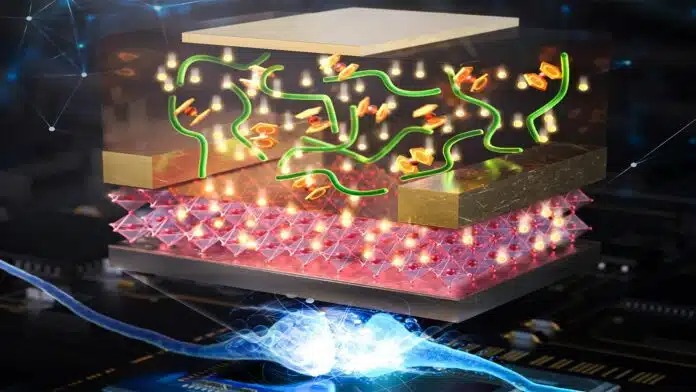Thursday, 08/01/2026 | 05:41 GMT+7
“Redox” refers to an electron-moving chemical process. Devices in microelectronics typically use an electric field to regulate the flow of electrons. In this experiment, researchers created a device that could regulate the flow of electrons by passing a voltage across a substance that served as an electron gate. Electrons would begin to flow through the gate from one material to another when the voltage reached a specific point, roughly half a volt.

Illustration of redox gating for carrier manipulation and electric field control of the electronic state. The green threads represent functional molecules for redox gating, and the ability to function at low power mimics synaptic switching in the human brain, as represented by the underlying synapse. (Image by Argonne National Laboratory.)
The device might function as a transistor by varying the voltage, allowing more or fewer electrons to flow.
Argonne materials scientist Dillon Fong, an author of the study, said, “The new redox gating strategy allows us to modulate the electron flow by an enormous amount even at low voltages, offering much greater power efficiency. This also prevents damage to the system. We see that these materials can be cycled repeatedly with almost no degradation in performance.”
Argonne materials scientist Wei Chen, one of the study’s co-corresponding authors, said, “Controlling the electronic properties of a material also has significant advantages for scientists seeking emergent properties beyond conventional devices.”
“The subvolt regime, where this material operates, is of enormous interest to researchers looking to make circuits that act similarly to the human brain, which also operates with great energy efficiency.”
The discovery of redox gating may help develop less power-hungry quantum materials. This methodology may find application in low-dimensional quantum materials composed of sustainable elements and various functional semiconductors.
Argonne’s Advanced Photon Source supported the research on redox gating behavior. Moreover, devices, materials, and electrical property measurements were performed at Argonne’s Center for Nanoscale Materials.
According to Techexplorist








 Webinar 2: “Financial Support for Energy Efficiency Enterprises – Opportunities and Challenges”
Webinar 2: “Financial Support for Energy Efficiency Enterprises – Opportunities and Challenges”
 Vietnamese enterprises achieve green growth and cut costs through energy efficiency
Vietnamese enterprises achieve green growth and cut costs through energy efficiency
 Capacity building for participating financial institutions in Ho Chi Minh City
Capacity building for participating financial institutions in Ho Chi Minh City
 Strengthening capacity for energy management officers of local government agencies
Strengthening capacity for energy management officers of local government agencies
 Strengthening Sales and Marketing Capacity for Energy Efficiency Equipment and Solution Suppliers
Strengthening Sales and Marketing Capacity for Energy Efficiency Equipment and Solution Suppliers
 Steel Enterprises Saving Energy and Enhancing Competitiveness
Steel Enterprises Saving Energy and Enhancing Competitiveness
 Capacity Building for Energy Officers of Government Agencies in the Central region
Capacity Building for Energy Officers of Government Agencies in the Central region